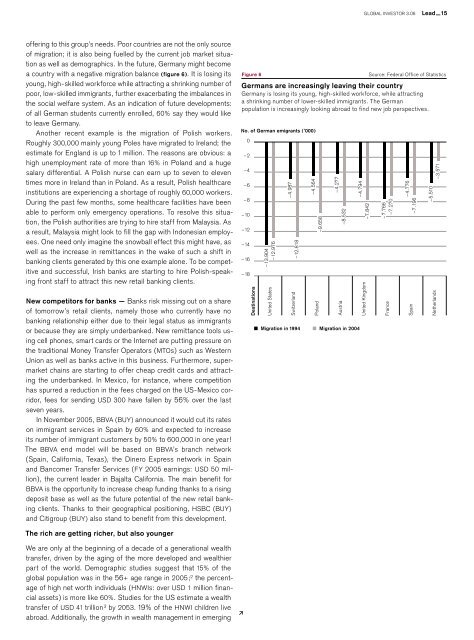Banking for 7 billion and 7 million
New challenges and opportunities of globalization Global Investor, 03/2006 Credit Suisse
New challenges and opportunities of globalization
Global Investor, 03/2006
Credit Suisse
You also want an ePaper? Increase the reach of your titles
YUMPU automatically turns print PDFs into web optimized ePapers that Google loves.
GLOBAL INVESTOR 3.06 Lead — 15<br />
offering to this group’s needs. Poor countries are not the only source<br />
of migration; it is also being fuelled by the current job market situation<br />
as well as demographics. In the future, Germany might become<br />
a country with a negative migration balance (figure 6). It is losing its<br />
young, high-skilled work<strong>for</strong>ce while attracting a shrinking number of<br />
poor, low-skilled immigrants, further exacerbating the imbalances in<br />
the social welfare system. As an indication of future developments:<br />
of all German students currently enrolled, 60% say they would like<br />
to leave Germany.<br />
Another recent example is the migration of Polish workers.<br />
Roughly 300,000 mainly young Poles have migrated to Irel<strong>and</strong>; the<br />
estimate <strong>for</strong> Engl<strong>and</strong> is up to 1 <strong>million</strong>. The reasons are obvious: a<br />
high unemployment rate of more than 16% in Pol<strong>and</strong> <strong>and</strong> a huge<br />
salary differential. A Polish nurse can earn up to seven to eleven<br />
times more in Irel<strong>and</strong> than in Pol<strong>and</strong>. As a result, Polish healthcare<br />
institutions are experiencing a shortage of roughly 60,000 workers.<br />
During the past few months, some healthcare facilities have been<br />
able to per<strong>for</strong>m only emergency operations. To resolve this situation,<br />
the Polish authorities are trying to hire staff from Malaysia. As<br />
a result, Malaysia might look to fill the gap with Indonesian employees.<br />
One need only imagine the snowball effect this might have, as<br />
well as the increase in remittances in the wake of such a shift in<br />
banking clients generated by this one example alone. To be competitive<br />
<strong>and</strong> successful, Irish banks are starting to hire Polish-speaking<br />
front staff to attract this new retail banking clients.<br />
New competitors <strong>for</strong> banks — Banks risk missing out on a share<br />
of tomorrow’s retail clients, namely those who currently have no<br />
banking relationship either due to their legal status as immigrants<br />
or because they are simply underbanked. New remittance tools using<br />
cell phones, smart cards or the Internet are putting pressure on<br />
the traditional Money Transfer Operators (MTOs) such as Western<br />
Union as well as banks active in this business. Furthermore, supermarket<br />
chains are starting to offer cheap credit cards <strong>and</strong> attracting<br />
the underbanked. In Mexico, <strong>for</strong> instance, where competition<br />
has spurred a reduction in the fees charged on the US-Mexico corridor,<br />
fees <strong>for</strong> sending USD 300 have fallen by 56% over the last<br />
seven years.<br />
In November 2005, BBVA (BUY) announced it would cut its rates<br />
on immigrant services in Spain by 60% <strong>and</strong> expected to increase<br />
its number of immigrant customers by 50% to 600,000 in one year!<br />
The BBVA end model will be based on BBVA’s branch network<br />
(Spain, Cali<strong>for</strong>nia, Texas), the Dinero Express network in Spain<br />
<strong>and</strong> Bancomer Transfer Services (FY 2005 earnings: USD 50 <strong>million</strong>),<br />
the current leader in Bajalta Cali<strong>for</strong>nia. The main benefit <strong>for</strong><br />
BBVA is the opportunity to increase cheap funding thanks to a rising<br />
deposit base as well as the future potential of the new retail banking<br />
clients. Thanks to their geographical positioning, HSBC (BUY)<br />
<strong>and</strong> Citigroup (BUY) also st<strong>and</strong> to benefit from this development.<br />
Figure 6<br />
Source: Federal Office of Statistics<br />
Germans are increasingly leaving their country<br />
Germany is losing its young, high-skilled work<strong>for</strong>ce, while attracting<br />
a shrinking number of lower-skilled immigrants. The German<br />
population is increasingly looking abroad to find new job perspectives.<br />
No. of German emigrants (’000)<br />
0<br />
–2<br />
–4<br />
–6<br />
–8<br />
–10<br />
–12<br />
–14<br />
–16<br />
–18<br />
Destinations<br />
–13.904<br />
–12.976<br />
United States<br />
–4.987<br />
–12.818<br />
Switzerl<strong>and</strong><br />
–4.564<br />
Pol<strong>and</strong><br />
–9.658<br />
–4.277<br />
–8.532<br />
Austria<br />
Migration in 1994 Migration in 2004<br />
–4.794<br />
–7.842<br />
United Kingdom<br />
–7.766<br />
–7.270<br />
France<br />
–4.776<br />
–7.196<br />
Spain<br />
–5.510<br />
–3.571<br />
Netherl<strong>and</strong>s<br />
The rich are getting richer, but also younger<br />
We are only at the beginning of a decade of a generational wealth<br />
transfer, driven by the aging of the more developed <strong>and</strong> wealthier<br />
part of the world. Demographic studies suggest that 15% of the<br />
global population was in the 56+ age range in 2005; 2 the percentage<br />
of high net worth individuals (HNWIs: over USD 1 <strong>million</strong> financial<br />
assets) is more like 60%. Studies <strong>for</strong> the US estimate a wealth<br />
transfer of USD 41 trillion 3 by 2053. 19% of the HNWI children live<br />
abroad. Additionally, the growth in wealth management in emerging

















